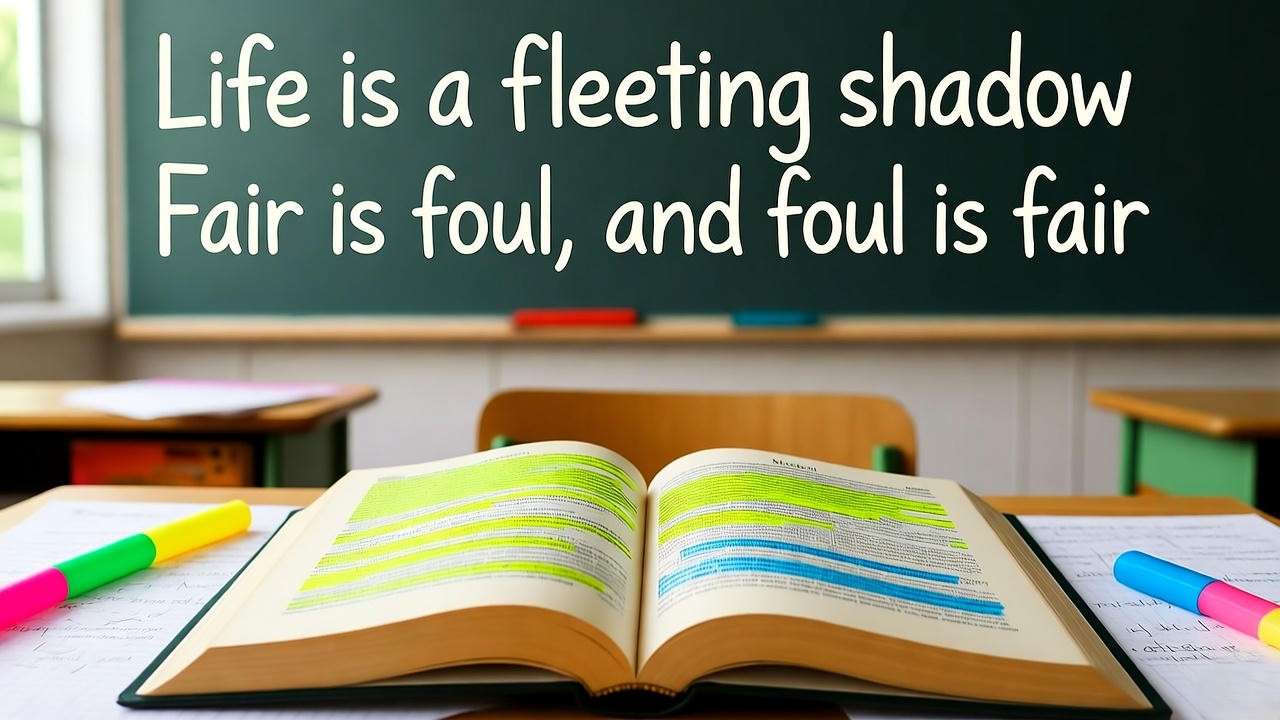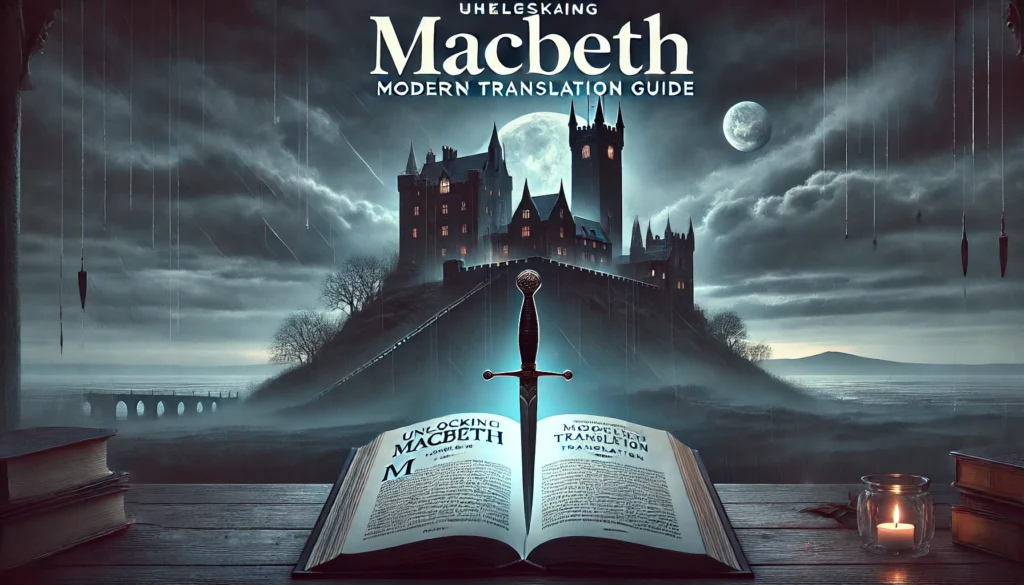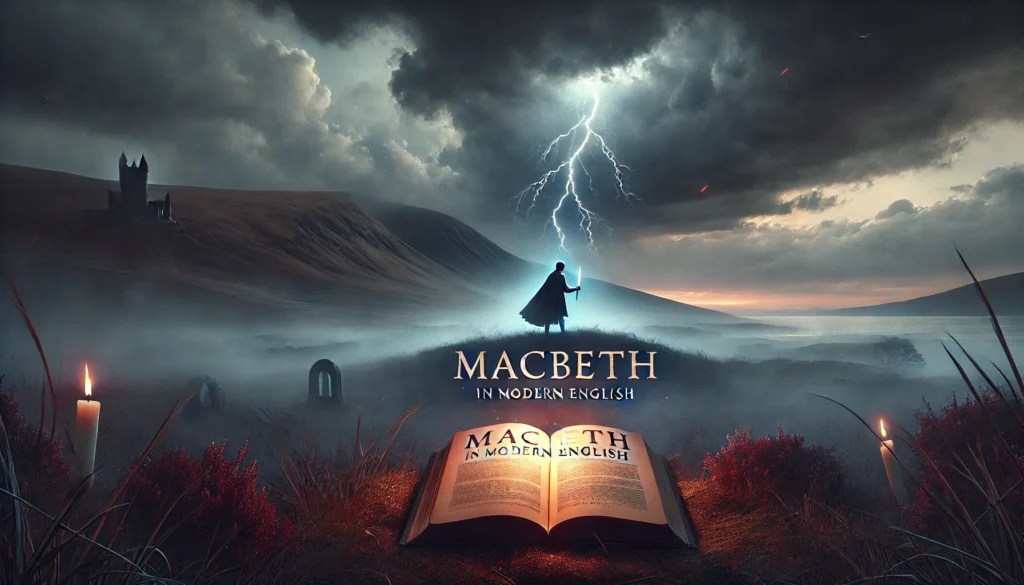Imagine a high school student, eyes glazing over, staring at a page of Macbeth filled with phrases like “thane” and “weird sisters,” feeling utterly lost in Shakespeare’s Elizabethan maze. This struggle is all too common, yet Macbeth remains a timeless masterpiece of ambition, guilt, and fate. For modern readers, a Macbeth translation can be the key to unlocking its brilliance, transforming confusion into captivation. As a Shakespeare scholar with years of teaching and analyzing his works, I’ve seen firsthand how translations make Macbeth accessible to students, educators, and casual readers alike. This comprehensive guide offers clear, engaging tools and insights to help you navigate Macbeth translations, ensuring you connect deeply with Shakespeare’s tragedy.
Whether you’re a student decoding the text for an exam, an educator sparking classroom discussions, or a theater enthusiast seeking a fresh perspective, this article provides practical solutions. We’ll explore why translations matter, the types available, how to choose the right one, and tips to enhance your experience—all backed by expert insights and authoritative resources.
Why Macbeth Translation Matters for Modern Readers
The Challenges of Shakespeare’s Language
Shakespeare’s Macbeth, written around 1606, is a linguistic treasure trove—but one that can feel like a locked vault. Its Elizabethan English, with iambic pentameter and archaic words, often stumps modern readers. Take the famous line, “Is this a dagger which I see before me, / The handle toward my hand?” In its original form, the imagery is vivid but the phrasing can feel alien. Words like “thane” (a Scottish noble) or “weird” (meaning fateful, not strange) require context to grasp fully. For non-native English speakers or those new to Shakespeare, these barriers can make Macbeth feel like a foreign language.
The Value of Accessible Translations
A quality Macbeth translation bridges this gap, preserving the play’s emotional depth and thematic richness while making it relatable. Translations clarify complex passages, allowing readers to focus on the story’s core: Macbeth’s descent into paranoia, Lady Macbeth’s guilt-ridden unraveling, and the eerie influence of the supernatural. For students, translations simplify exam preparation; for casual readers, they make Macbeth an enjoyable dive into human nature. As Dr. Emma Smith, a renowned Shakespeare scholar at Oxford, notes, “Translations keep Shakespeare’s works alive by inviting new generations to engage with his universal themes.”
Understanding Macbeth’s Core Themes and Context
Historical and Cultural Context
To fully appreciate a Macbeth translation, understanding its context is crucial. Set in 11th-century Scotland, the play reflects a turbulent world of feudal loyalty and political intrigue. Written for King James I, who was fascinated by witchcraft, Macbeth weaves in supernatural elements like the Weird Sisters to captivate its original audience. This historical backdrop shapes the play’s exploration of power and betrayal, making translations that include contextual notes especially valuable. Knowing why Shakespeare emphasized witches or Scottish kingship helps readers connect the dots between his era and ours.
Key Themes in Macbeth
Macbeth explores universal themes that resonate today: ambition, power, guilt, fate versus free will, and the supernatural. For example, Lady Macbeth’s soliloquy—“Come, you spirits / That tend on mortal thoughts, unsex me here”—reveals her ruthless ambition, a trait that feels strikingly modern in corporate or political arenas. A good translation might rephrase this as, “Spirits, strip away my femininity and fill me with cruelty,” clarifying her psychological intensity. These themes, when made accessible, allow readers to see Macbeth as more than a dusty classic—it’s a mirror to human nature.
Tip: As you read, jot down how Macbeth’s themes echo modern issues, like unchecked ambition in leadership or the psychological toll of guilt.
Types of Macbeth Translations Available
Literal Translations
Literal translations aim to update Shakespeare’s words to modern English while preserving the original structure. For instance, the “Tomorrow, and tomorrow, and tomorrow” soliloquy might become, “Tomorrow, and tomorrow, and tomorrow creeps along at this slow pace.” These translations are ideal for readers who want to stay close to Shakespeare’s rhythm but need clearer language. However, they can feel stiff, lacking the poetic flow that interpretive versions offer. The Folger Shakespeare Library’s editions often include literal translations alongside the original text.
Paraphrased or Interpretive Translations
Interpretive translations prioritize emotional impact and readability, rephrasing Macbeth to resonate with modern audiences. For example, the witches’ prophecy, “All hail, Macbeth! Hail to thee, Thane of Cawdor!” might become, “Greetings, Macbeth! You’ll soon be Lord of Cawdor!” These versions shine for casual readers or theater productions, making dialogue feel natural. However, they risk straying from Shakespeare’s nuances. The No Fear Shakespeare series excels here, offering side-by-side original and modern texts.
Performance-Based Adaptations
Performance-based translations are tailored for stage or screen, balancing fidelity with accessibility. The 2015 Macbeth film, starring Michael Fassbender, uses a streamlined script that modernizes key lines while retaining Shakespeare’s intensity. For instance, the witches’ chant, “Double, double toil and trouble,” might be adapted to emphasize rhythm for actors. As theater director Gregory Doran explains, “Performance translations must breathe life into the text, making it immediate for audiences while honoring Shakespeare’s intent.”
How to Choose the Right Macbeth Translation for You
For Students
Students often need translations that clarify Macbeth for exams or essays. The No Fear Shakespeare series is a top choice, offering side-by-side original and modern text. For example, Macbeth’s “If it were done when ’tis done” speech is translated as, “If the deed could be finished once it’s done,” helping students grasp his moral dilemma. Look for editions with glossaries and study questions, like those from Arden Shakespeare, to support deeper analysis.
Tip: Create a study guide by pairing key quotes with their translations to streamline revision.
For Educators
Educators benefit from translations that spark discussion and engagement. The Folger Shakespeare Library’s editions include notes on historical context and teaching prompts, ideal for classroom use. For instance, translating the witches’ scenes can lead to debates about fate versus choice. Pair these with activities like rewriting a scene in students’ own words to deepen understanding.
For Casual Readers and Theater Fans
Casual readers and theater enthusiasts should seek narrative-driven translations, like those in Manga Shakespeare or novelized adaptations. These make Macbeth feel like a gripping story rather than a dense text. For theater fans, exploring translations used in productions—like the 2021 The Tragedy of Macbeth with Denzel Washington—offers insight into how directors modernize the play for impact.
Checklist for Choosing a Translation:
- Readability: Does the text feel clear and engaging?
- Fidelity: Does it retain Shakespeare’s themes and tone?
- Supplementary Materials: Are there notes, glossaries, or historical context included?
Top Recommended Macbeth Translations and Resources
Print and Digital Editions
- Folger Shakespeare Library: Offers accurate texts with extensive notes, glossaries, and essays on Macbeth’s themes.
- Arden Shakespeare: Ideal for scholars, with detailed annotations and critical essays.
- No Fear Shakespeare: Perfect for beginners, with side-by-side original and modern text.
Online Tools and Apps
Digital resources make Macbeth translations accessible anywhere. Shakespeare’s Words (shakespeareswords.com) provides glossaries and line-by-line explanations. MIT’s free Macbeth text (shakespeare.mit.edu) includes annotations for deeper study. Apps like LitCharts offer mobile-friendly summaries and translated quotes, ideal for quick reference.
Audiovisual Resources
Film and audio adaptations bring Macbeth to life. The BBC Radio Shakespeare series features modernized dialogue for clarity. The 2021 The Tragedy of Macbeth, directed by Joel Coen, uses accessible language to highlight the play’s stark visuals and emotional weight. As librarian Dr. Miranda Wilson notes, “Audiovisual translations make Shakespeare’s language feel immediate, especially for visual learners.”
Practical Tips for Engaging with Macbeth Translations
Reading Strategies
To make the most of a Macbeth translation, adopt active reading techniques. Start by annotating key passages, noting how translated phrases clarify meaning. For example, the witches’ chant, “Double, double toil and trouble / Fire burn, and cauldron bubble,” might be translated as, “Double, double, work and strife / Let the fire burn and the potion boil.” Summarize each scene in your own words to solidify understanding, focusing on how the translation reveals character motivations or plot twists. Reading aloud can also help, as it mimics the play’s theatrical roots and highlights the rhythm of modernized dialogue.
Example: Try breaking down Act 4, Scene 1 (the witches’ prophecy scene). Write the original lines, then the translated version, and note how the modern phrasing clarifies the witches’ cryptic predictions.
Using Translations for Performance or Study
For actors or directors, Macbeth translations are invaluable for preparing roles. Modernized dialogue helps performers internalize lines and convey emotions authentically. For instance, translating Macbeth’s “Out, out, brief candle!” into “Extinguish, extinguish, fleeting light!” can inspire a more visceral delivery. Students can use translations to create flashcards pairing original and modern quotes, aiding memorization for exams. For example, pair “Life’s but a walking shadow” with “Life is just a fleeting illusion” to grasp Macbeth’s despair.
Tip: Actors should practice translated lines in rehearsals to find natural intonations, while students can use translations to draft essays comparing Macbeth’s psychological decline across acts.
Avoiding Common Pitfalls
Not all translations are created equal. Overly simplified versions can strip away Macbeth’s poetic depth, reducing its emotional impact. For example, translating “Tomorrow, and tomorrow, and tomorrow” as “The future keeps coming” loses the soliloquy’s meditative weight. Avoid translations that prioritize brevity over nuance, as they may obscure Shakespeare’s intent. Instead, opt for editions like Folger or Arden, which balance clarity with fidelity. Cross-reference multiple translations to ensure you’re capturing the full scope of a scene’s meaning.
Tip: When in doubt, compare a translated passage with the original to check for missing themes or imagery.
How Macbeth Translations Enhance Appreciation of Shakespeare
Bringing Characters to Life
Translations breathe new life into Macbeth’s characters, making their struggles relatable. Lady Macbeth’s soliloquy, “Out, damned spot! Out, I say!” becomes “Get out, cursed stain! Get out!” in a modern translation, emphasizing her guilt-driven madness. This clarity helps readers empathize with her psychological unraveling. Similarly, Macbeth’s internal conflict—“I have no spur / To prick the sides of my intent”—might be translated as “I lack the drive to push my ambition forward,” highlighting his hesitation. These modern phrasings make characters feel like real people, not distant relics.
Example: In Act 5, Scene 5, Macbeth’s despairing “Tomorrow” soliloquy gains immediacy when translated, allowing readers to connect with his existential crisis.
Connecting with Universal Themes
Translations bridge the gap between Shakespeare’s 17th-century world and today’s audiences, illuminating Macbeth’s timeless themes. Ambition, for instance, resonates in modern contexts like corporate greed or political power struggles. A translation might rephrase Macbeth’s “Vaulting ambition, which o’erleaps itself” as “Unrestrained ambition that trips over itself,” making the concept accessible. Guilt, another core theme, shines through in translated scenes like Lady Macbeth’s sleepwalking, where her torment feels universal. As literature professor Dr. James Shapiro notes, “Translations allow modern readers to see Shakespeare’s themes as mirrors to their own lives, fostering emotional connections.”
Example: Relate Macbeth’s ambition to a modern CEO’s ruthless climb, or Lady Macbeth’s guilt to the psychological toll of ethical compromises.
FAQs About Macbeth Translations
What’s the Best Macbeth Translation for Beginners?
For those new to Shakespeare, the No Fear Shakespeare series is ideal, offering side-by-side original and modern text. Its clear translations, like turning “Fair is foul, and foul is fair” into “What’s good is bad, and what’s bad is good,” simplify complex ideas without losing meaning. The series also includes summaries and glossaries, making it perfect for first-time readers.
Do Translations Lose the Original Meaning of Macbeth?
High-quality translations preserve Macbeth’s themes, emotions, and imagery, though some nuance may shift. For example, translating “Weird Sisters” as “Fateful Sisters” retains their prophetic role but loses the archaic flavor. Trusted editions like Folger or Arden minimize such losses by pairing translations with detailed notes, ensuring readers grasp Shakespeare’s intent.
Are There Free Macbeth Translations Online?
Yes, free resources abound. MIT’s Shakespeare Project (shakespeare.mit.edu) offers the full Macbeth text with annotations, while Project Gutenberg (gutenberg.org) provides public-domain versions. Websites like Shakespeare’s Words offer searchable glossaries to clarify terms, making them excellent companions to free texts.
How Do I Use Translations to Teach Macbeth in a Classroom?
Educators can use translations to make Macbeth engaging. Assign students to compare original and translated scenes, like the witches’ prophecy, to discuss how language shapes meaning. Use No Fear Shakespeare for group readings, then have students rewrite a soliloquy in their own words to explore themes like guilt or ambition. Incorporate film clips from modernized adaptations to spark discussion.
Can Translations Help with Understanding Macbeth’s Soliloquies?
Absolutely. Soliloquies, like Macbeth’s “Is this a dagger” speech, are dense with imagery and emotion. Translations simplify these, such as rendering “This supernatural soliciting / Cannot be ill” as “This eerie temptation can’t be evil,” helping readers unpack Macbeth’s moral struggle. Pair translations with audio performances to hear the soliloquy’s rhythm.
Macbeth translations are a gateway to Shakespeare’s haunting tragedy, transforming its complex language into a vivid, accessible story of ambition, guilt, and fate. Whether you’re a student decoding the text, an educator inspiring your classroom, or a theater fan savoring the drama, the right translation can unlock Macbeth’s brilliance. Explore trusted editions like Folger or No Fear Shakespeare, dive into a scene with a modernized version, or watch an adaptation like The Tragedy of Macbeth to see the play come alive. As a Shakespeare scholar, I’ve seen translations ignite passion for this play—now it’s your turn.













